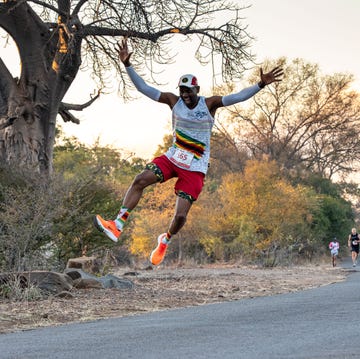The oldest annual marathon, the Boston Marathon – one of the Abbott World Marathon Majors – is also one of the most famous, prestigious and idiosyncratic road races on the planet. Organised by the Boston Athletic Association (BAA) and hosted by the US state of Massachusetts, it is an endlessly popular and oversubscribed event, with a field size that is capped at around 30,000 runners each year. It is also one of the most vibrant and best supported 26.2-mile races out there, with 50,000 or so enthusiasts lining the roadsides to cheer on runners every time.
For many, just getting to the start line of the Boston Marathon is a lifetime goal, as runners must achieve a qualifying time at another marathon to even be considered for a place. However, despite the challenging entry requirements, the unique atmosphere and history of the race continues to enchant and entice runners from across the globe.
Here’s everything you need to know about the 2025 Boston Marathon – and how to qualify for a place in future editions of the race.
What everyone's reading
When is the 2025 Boston Marathon?
This year’s Boston Marathon – the 129th running of the event – will take place on Monday 21 April.
What time does the Boston Marathon start?
Here’s where the quirks begin. Three hours and six minutes after a ceremonial ‘Military March’ at 6am, proceedings kick off with the men’s wheelchair race, which starts at precisely 9:06am, followed by the women’s wheelchair race at 9:09am. (There’s no rounding up or down of timings here.)
Handcyclists and duo teams then start at 9:30am, before the elite men get going at 9:37am, the elite women at 9:47am and the para athlete division at 9:50am. Mass participation runners then set off in four waves from 10am, in 25-minute intervals.
How do I get my race bib?
You’ll need pick up your race bib at the Boston Marathon Expo, which will be held in the John B. Hynes Veterans Memorial Convention Center at 900 Boylston Street in Boston. It is free to attend and open to the public, so if you're running, you can bring friends and family along with you.
The 2025 Boston Marathon Expo will be open at the following times:
- Friday 18 April: 10am-7pm
- Saturday 19 April: 9am-7pm
- Sunday 20 April: 9am-6pm
Here, you’ll also be able to collect an official kit bag to use for the bag drop on race day. No other bags will be accepted at the bag drop, so it’s vital that you pick this up if you want to use the baggage facility.
How do I get to the start line?
The best way to get to the Boston Marathon start line is – wait for it – by school bus. You read that correctly.
The official transportation for the race, these traditional yellow school buses pick up runners from Charles Street, located between the Public Garden and Boston Common in the city centre, and transport them all the way to the start area in Hopkinton, which is 26.2 miles away almost as the crow flies. The bus journey is a surreal experience that takes about an hour, emphasising just how far a marathon is.
Bus loading starts at 6:45am and finishes at 9am, with the final bus departing at 9:30am. Your bib number will dictate the time that you’ll need to take your seat.
Just before you board a school bus, you can drop off a bag at the bag drop areas on Boylston Street or Berkeley Street – whichever one corresponds with your bib number. Again, only the official kit bag that you collected at the Boston Marathon Expo will be accepted at the bag drop.
How do I qualify for the Boston Marathon?
To qualify for the Boston Marathon, you need to run a qualifying time in another eligible marathon. For context, an eligible marathon has a course that has been certified by a national body, such as England Athletics, USATF or AIMS.
The time that you need to run depends on what age and gender category you fall into, as detailed in the table below. It’s important to understand that running a qualifying time does not guarantee entry, though – if the total number of people submitting valid qualifying times exceeds the number of spaces available in the race, then places will be allocated on a fastest-first basis. For many years, thousands of qualifiers have missed out on entries into the race for this reason.
The qualifying window for the Boston Marathon runs for approximately one calendar year. For the 2025 race, it began on 1 September 2023 and finished on 13 September 2024, which was the day that entries closed.
Why is the Boston Marathon always on a Monday?
Since its first edition in 1897, the Boston Marathon has always been held on Patriot’s Day, a public holiday in the US states of Massachusetts and Maine. Since Patriot’s Day was fixed as 19 April at the time, the race would simply take place on whatever day of the week 19 April fell that year.
In 1969, however, the public holiday was officially moved to the third Monday in April – and so, the Boston Marathon moved to the third Monday in April as well. To add to the holiday spirit, the 2025 Boston Marathon will take place on the 250th anniversary of Patriot’s Day – a true ‘medal Monday’ occasion.
How tough is the Boston Marathon?
Unless you know the route like the back of your hand, Boston is a hard race to execute well. Featuring a long, fast downhill section at the start, a set of punchy hills near the end and a steady stream of lumps and bumps – and essentially no flat sections – in between, the elevation profile often catches runners off guard and sees many commit the classic marathon sin of setting off too fast and regretting it by the end.
But that’s not to say that you can’t get a fast time, or even a PB, in Boston. In fact, in 2011, Kenya’s Geoffrey Mutai ran the Boston Marathon in a sublime 2:03:02, which, at the time, would have broken the men’s marathon world record by nearly a minute. The catch? The Boston Marathon course is not eligible for world records. To be eligible, courses must have start and finish points that are relatively close to one another and which sit at roughly the same elevation. The Boston Marathon, however, is a point-to-point, net-downhill course that follows a near-straight line from the small, twee town of Hopkinton all the way to Boylston Street, in the bustling heart of Boston city centre. Plus, runners often enjoy a tailwind when running the Boston Marathon, which again invalidates world records.
If it’s any consolation to Mutai, his Boston Marathon time from 2011 still stands as the men’s course record. On the women’s side, Ethiopia’s Buzunesh Deba set the course record in 2014, having seized the win in a spectacular 2:19:59.
What exactly is Heartbreak Hill?
Heartbreak Hill has become synonymous with the Boston Marathon. It is the last and steepest in a series of four hills in the leafy, affluent suburb of Newton – and it comes when runners already have 20 miles in their legs. While most runners will have encountered steeper hills elsewhere, the cruel placement of Heartbreak Hill makes it particularly arduous, especially for those who conquered the initial downhill section of the course too quickly. (As noted previously, many runners succumb to premature speed.)
As for the name ‘Heartbreak Hill’, this derives from the 1936 edition of the race. Here, Ellison ‘Tarzan’ Brown, a Native American runner of the Narragansett tribe, is in the lead by the time he arrives at the Newton hills. However, the hills are tough and the race favourite and returning champion, Johnny Kelley, soon catches him up and looks set to overtake. But Tarzan – who came 13th at the 1935 Boston Marathon, wearing shoes so threadbare that they completely fell apart with seven miles to go – found a new gear to power on and secure victory. According to journalists at the time, he broke the champion’s heart in the process – hence the nickname that lives to this day.
What’s the weather usually like for the Boston Marathon?
The weather can be erratic and tricky to predict on race day. While it has been swelteringly hot on some years, on others, it has been miserably wet and cold.
At the 2018 Boston Marathon, for example, the torrential rain and high winds forced more than half of the elite field to drop out, with Des Linden and Yuki Kawauchi managing to endure the elements to win the race in, understandably, much slower times than normal. At the 2012 Boston Marathon, meanwhile, runners faced heat exceeding 30ºC.
As a ballpark figure, the average high temperature for April in Boston is 13.8ºC, while the average low is 5ºC, with a 37% chance of rain. But, as with all marathons, you can’t dictate what conditions you’ll get on the day – so check the forecast and prepare for any eventuality in training.
Can I defer my place if I’m injured?
Unfortunately, you cannot defer your place in the Boston Marathon if you are injured – so you’ll have to re-qualify for a future edition of the race. If you purchased race insurance at the time of registering, though, you may be able to claim a refund for your race fee.
Thanks to the BAA’s pregnancy and postpartum deferral policy, runners who are pregnant or postpartum can defer their Boston Marathon entry for up to two years.
















